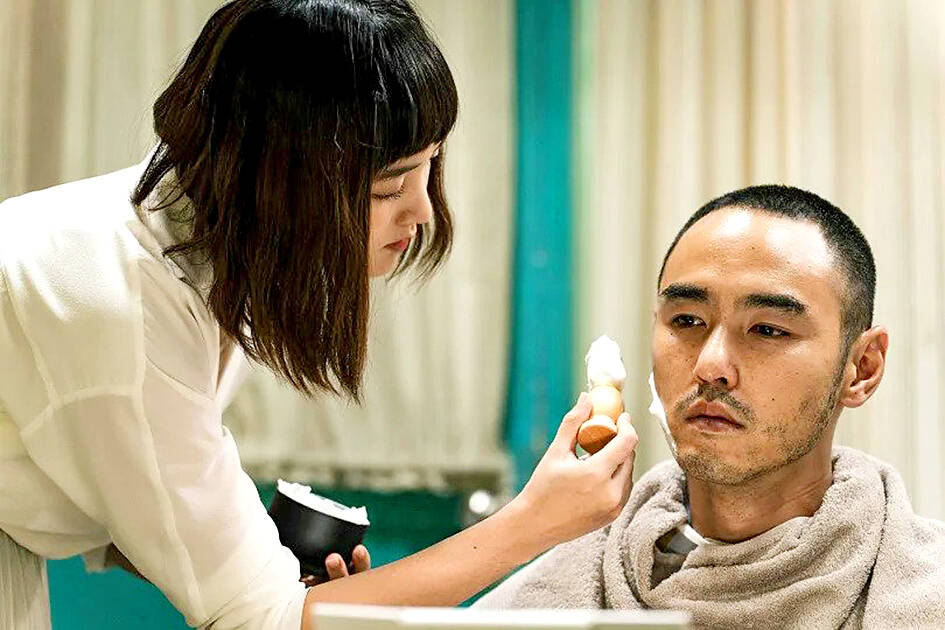Taiwanese cinema’s fascination with gangsters and senseless violence continues with The Pig, The Snake and The Pigeon (周處處三害), inspired by the fifth-century Chinese fable Zhou Chu Eradicates the Three Scourges. This one is a bit different, however, as it minimizes the brotherhood element for a darker tale of a desperate fugitive who will do almost anything to leave his mark on history.
Although there are clear parallels, the folk tale has a very different moral message. Prompted by a villager, local hoodlum Zhou Chu sets out to rid his town of the three evil beings who have been terrorizing the area. After dispatching a vicious tiger, he spends three days battling a dragon. When he prevails and returns, he sees the villagers celebrating as they thought he had died with the dragon. Zhou soon realizes he is the third scourge and decides to change his ways, becoming an upright man of integrity. Eventually he becomes a beloved general who dies on the battlefield.
Protagonist Chen Gui-lin (Ethan Juan, 阮經天), on the other hand, has no such noble intentions. In hiding after committing a series of brazen assassinations of rival gang bosses, he decides (through throwing divination blocks) to turn himself in after learning that his grandmother has died and that he has stage four lung cancer. At the police station, however, he realizes he is just number three on the most wanted list. Wanting to go out in a blaze of glory, and having nothing more to lose with his grandmother gone, he vows to take the top two criminals out first so he can claim the top spot.

Photo courtesy of An Attitude Production Co
“I’m not afraid of death,” he says in one scene. “I’m afraid that people don’t know my name!”
But instead of going on an all-out rampage, the rest of the movie portrays Gui-lin a sympathetic character, despite his shallow motives and violent behavior. His two targets, Hongkie and Lin Lu-he, are convincingly portrayed by Ben Yuen (袁富華) and Chen Yi-wen (陳以文) as depraved, sinister scumbags, making Gui-lin seem almost angelic in comparison as he inadvertently saves others from their tyranny.
Despite his simplemindedness and trigger-happy tendencies, Gui-lin still has somewhat of a conscience, making one want to know more about his backstory; however that isn’t flushed out at all. Instead, too much is focused on unconvincing heart-rending scenes that merely prove that he has a conscience.

Photo courtesy of An Attitude Production Co
These more tender moments are provided by the three characters who interact personally with Gui-lin — the detective on his trail (Lee Lee-zen, 李李仁), his underworld doctor (Cherry Hsieh, 謝瓊煖) and the girl he saves (Gingle Wang, 王淨) — but they’re simply not featured enough to provide enough emotional weight. Still, it’s a compelling character study, and Juan does a great job toeing the line between tragic hero and impulsive madman.
The film is made more entertaining with absurdist elements that soften the violence, though often to the point that many of the scenes are simply not very believable. There are also some interesting twists and symbolism about redemption and rebirth that provide depth to the narrative. It surely has its flaws, but The Pig, The Snake and The Pigeon is still an intriguing take on the gangster genre that smartly avoids relying too much on action scenes to maintain its intensity.

Photo courtesy of An Attitude Production Co

This is the year that the demographic crisis will begin to impact people’s lives. This will create pressures on treatment and hiring of foreigners. Regardless of whatever technological breakthroughs happen, the real value will come from digesting and productively applying existing technologies in new and creative ways. INTRODUCING BASIC SERVICES BREAKDOWNS At some point soon, we will begin to witness a breakdown in basic services. Initially, it will be limited and sporadic, but the frequency and newsworthiness of the incidents will only continue to accelerate dramatically in the coming years. Here in central Taiwan, many basic services are severely understaffed, and

Jan. 5 to Jan. 11 Of the more than 3,000km of sugar railway that once criss-crossed central and southern Taiwan, just 16.1km remain in operation today. By the time Dafydd Fell began photographing the network in earnest in 1994, it was already well past its heyday. The system had been significantly cut back, leaving behind abandoned stations, rusting rolling stock and crumbling facilities. This reduction continued during the five years of his documentation, adding urgency to his task. As passenger services had already ceased by then, Fell had to wait for the sugarcane harvest season each year, which typically ran from

It is a soulful folk song, filled with feeling and history: A love-stricken young man tells God about his hopes and dreams of happiness. Generations of Uighurs, the Turkic ethnic minority in China’s Xinjiang region, have played it at parties and weddings. But today, if they download it, play it or share it online, they risk ending up in prison. Besh pede, a popular Uighur folk ballad, is among dozens of Uighur-language songs that have been deemed “problematic” by Xinjiang authorities, according to a recording of a meeting held by police and other local officials in the historic city of Kashgar in

It’s a good thing that 2025 is over. Yes, I fully expect we will look back on the year with nostalgia, once we have experienced this year and 2027. Traditionally at New Years much discourse is devoted to discussing what happened the previous year. Let’s have a look at what didn’t happen. Many bad things did not happen. The People’s Republic of China (PRC) did not attack Taiwan. We didn’t have a massive, destructive earthquake or drought. We didn’t have a major human pandemic. No widespread unemployment or other destructive social events. Nothing serious was done about Taiwan’s swelling birth rate catastrophe.